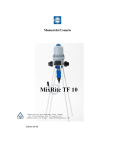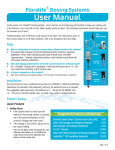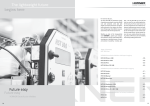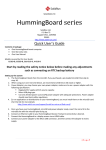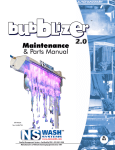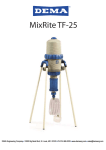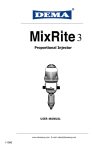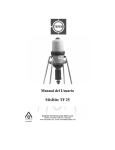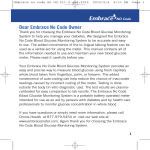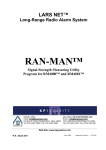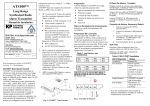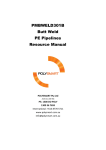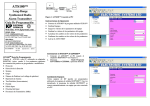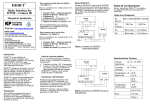Download MixRite TF 10
Transcript
User's Manual MixRite TF 10 Edition 05.08 1 Tefen MixRite TF 10 fertilizer and chemicals Injector Congratulations on your purchase of one of Tefen’s high quality products. To get the best results from the MixRite TF-10 Proportioning Dosing Injector it is important to spend a few minutes reading carefully the explanations and recommendations in this user's manual. Operating the Injector The proportioning dosing injector is fitted on the water line. The flow of water passing through the injector activates it and causes the pumping of liquid fertilizer (or other liquid additive) and injects it in a relative quantity into the water line. The MixRite TF 10 proportioning dosing injector will operate in the following conditions: The flow rate of the water passing through the injector is Between 0.5 and 10 m3/hour (2 and 45 GPM). The water pressure is between 1 and 8 bar (14.7 and 120 PSI). The water & air temperatures are not less than 4ºC and not more than 40ºC. (39ºF and not more then 104ºF) Head loss: Low flow 0.1 Bar – High flow 0.9 Bar The flow rate of the fertilizer and chemical can be adjusted relative to the flow rate of the water in the range of 0.1% to 1% for Model 01 0.2% to 2% for Model 02 1% to 5% for Model 05. Installing the Injector Check that Injector package contains the following items: One proportioning dosing injector to which are attached two couplings (Plasson) for a 50 mm. PE pipe or two BSPT 1½” or NPT1½” threaded couplings according to the model. One flexible suction tube to which is attached a flat seal and a filter. One stand that includes 4 feet and 2 brackets (optional) One User's manual To fit to a wall – connect one of the brackets to the wall by inserting 4 screws in the bracket holes. 2 To install the stand – insert the brackets to the grooves of the body at the bottom and press up until they fit in place. Place the legs in the holes and press until they lock. Connection of the suction tube Insert the flat seal into the nut of the coupling on the end of the tube (1). Thread and tighten the nut to the inlet valve on the underside of the injector. Make sure that the nut is threaded and tightened properly (2, 3). Connection of the Injector to a 1½” line - MixRite TF 10 Note the direction of the water flow. Place the injector so that the arrow stamped on the body of the injector and the red arrow point in the direction of the water flow. Connect the injector using the plastic couplings. 3 Connection of the Injector to a 50 mm. polyethylene line - MixRite TF 10 Note the direction of the water flow. Place the injector so that the arrow stamped on the body of the injector and the red arrow point in the direction of the water flow. Make sure that the ends of the entry pipe and exit pipe are cut straight and that the end is in the shape of a rounded cone. The distance between the entry end and the exit ends should be about 20 cm. (7.87") Remove the 50 mm nut from the injector and the white ring and slide them onto the pipe at a short distance from the end. Check that there is an accessory seal 50 and that the sealing 50 fixture closes the unit from outside. 1) Insert the pipe into the entry opening or exit opening in accordance with the direction indicated and push it so that the pipe penetrates, passes the seal and stops at the end of the track. To facilitate the penetration of the pipe spread a little silicone grease on the end of the tube before inserting it. Push the white ring in until it reaches the thread (2). Close the nut and tighten securely. In the same way connect the injector to the other pipe. 4 Installing the injector on an irrigation line It is recommended to fit a main valve(1) at the beginning of the line as well as backflow a prevention valve (3). 3 On a drinking water line, according to local regulations, it is obligatory to install a backflow prevention valve to prevent entry of chemicals into the drinking water. Then as shown in the diagram the following have to be installed: A pressure reducer(4) to protect the injector from excess pressure, a filter (2) of at least 75 mesh, a valve (6) before entry to the injector vacuum valve(7)to prevent siphoning when the injector is not operating, and valves to the feed lines have then to be installed. It is advisable to add a bypass pipe through which the water can flow to allow irrigation without fertilizer or when it is required to dismantle the injector. Installation of the injector on a bypass line It is necessary to fit the proportional dosing injector to a bypass line when irrigating with a flow rate higher than the maximum recommended for the injector. The bypass enables only part of the water flow to pass through the bypass and activate the injector, while the remainder passes through the main line. Using the choke valve (7) on the main line, the flow of water passing through the main line is regulated so that the rest of the flow passes through the bypass and activates the injector. The metering must be calculated in accordance with the flow rate passing through both lines. It is necessary to fit a main valve (1)at the beginning of the line and after it a backflow prevention valve (3),pressure reducer(4),a water filter(2)of at least 75 mesh, a T connection (A) for diversion from the main line to the bypass, a valve on the bypass before the inlet to the proportioning dosing injector, a valve after the outlet from the injector (9)on the bypass, and a T-connector for the return to the main line.(B). A choke valve, preferably an angled valve, should be fitted on the main line between the bypass junction and the return connection, to regulate the flow rates between the main line and the bypass. An anti vacuum valve (8)should be fitted together with valves for the branch lines after the return connection from the bypass. 5 Installation of two injectors in parallel When the water flow rate in the irrigation line is higher than the maximum nominal flow rate of the injectors, the water may be divided between two injectors. If the 2 injectors are used for pumping the same type of fertilizer, the scales should be adjusted in an identical manner to the same level of metering. Two different additives may be metered at different levels. The metering in each unit must be calculated separately for each flow rate passing through each of the two injectors. It is necessary to fit a main valve(1)at the beginning of the water line and after it, a backflow prevention valve(3),a pressure reducer(4), a filter(2) with at least a 75 mesh. A T-junction(5)is then fitted from the main line into 2 lines. To each of these lines are fitted a regulation valve (6), the injector, and a non-return valve immediately after the injector(7)and a connection back to the main line (8). Care must be taken to ensure that both branches are exactly the same length. . 6 Connection to the Fertilizer Tank Connect the suction tube to the fertilizer tank (preferably about 5 cm (2") above the bottom). The liquid fertilizer must be passed through a filter with at least a 120 mesh. If the fertilizer is drawn from an open tank, a heavy weight should be placed at the end of the suction tube that will keep the opening of the suction tube inside the additive liquid and prevent the tube from floating and falling outside the tank. Make sure that the level of the fertilizer is always below the injector. Otherwise uncontrolled flow of the fertilizer may occur. When connecting to a large fertilizer tank use a valve that is not affected by the fertilizer and an N.C. valve to prevent the siphon effect. The valve will only open when there is water pressure in the irrigation line. Adjustment of Metering On the metering cylinder there is a scale indicating the percentage of additives. When the entry valve is closed and there is no water pressure in the injector turn the adjustment control nut and set its upper edge on the percentage required. Turning it counterclockwise increases the amount of fertilizer metered. Turning it clockwise decreases the amount of fertilizer metered. The actual fertilizer metering rate should be checked. If necessary, adjust by increasing or decreasing the adjustment control nut. 7 Manual On/Off Control In models with a manual on/off control the suction can be controlled while the water flows through the injector. Turning the on/off handle clockwise to the end of the threads stops the suction. Turning the on/off handle counter clockwise till it is fully open starts the operation of the suction unit. Hydraulic On/Off Control In models with a hydraulic on/off control the suction can be controlled while the water continues to flow through the injector, using a connection to the control tubes that are controlled by the irrigation computer by means of electric valves. Routine Maintenance Regularly clean the water filter at the injector inlet and the fertilizer suction filter. If it is planned not to operate the injector for a long period, operate the injector for a few minutes with the metering tube immersed in a tank with clean water to remove fertilizer residues from the injector preventing them solidifying in the injector. If there is a fear of frost, and the temperature falling below 4° C° (39ºF), empty the water from the injector. To do this, close the entry and exit valves securely. Open and dismantle the 1” record nut that connects the suction pipe. Press the backflow prevention valve using a finger or a thin rod, allowing all the water that has collected in the injector to drain out while pressing the air release valve at the top of the injector 8 Troubleshooting Guide Problem Check The injector does not The injector is fitted with the arrows in the work opposite direction to the water flow. Solution Fit the injector with the arrows in the direction of the water flow. The inlet and outlet valves are closed. Open the valves The inlet filter is blocked. Clean the filter. There is no water flow at the appropriate Open the main valve. pressure. The injector has There is no water flow at the appropriate stopped working pressure. Open the main valve. Open the nut Replace the motor seals. locking the motor cover, remove the motor cover, and remove the mechanism. Check if the motor seals are defective. Check if the springs are broken. Replace the springs. Check if the seals above the valves are Replace the seals. defective or have been displaced. Check if one of the parts of the mechanism Replace the broken part. is broken. There is a leak from The leak is from the connection between the Open and remove the motor the injector. body and the cover. cover, replace the seal, fit the cover, and thoroughly tighten the cover locking nut. The leak is from the connection of the Remove the suction tube, replace suction tube. the defective seal and reconnect. The leak is from the non-return valve. Dismantle the non-return valve and replace the defective seal. There is no suction. The suction filter is blocked. Clean the filter. Dismantle the injector unit and check if the Replace the suction seal. suction seal is defective. The non-return valve is defective. Replace the non-return valve. For advice, technical support and purchase of spare parts, contact the authorized sales representative in your area. 9









